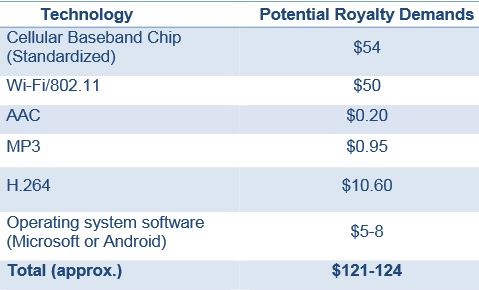Patent insanity: Royalty fees could reach $120 on a $400 smartphone

A working paper on smartphone royalties has calculated from a "bottom up" analysis that the potential patent royalties on a hypothetical $400 smartphone could be over $120. This is more than the cost of the components.
The authors say that the cost of the royalty stack "may be undermining industry profitability and, in turn, diminishing incentives to invest and compete". This is the opposite of what patent royalties are supposed to do.
The Smartphone Royalty Stack is a 69-page paper that goes through all the elements of a smartphone, and adds up the potential payments based on the rapidly-increasing number of patent lawsuits. Because the smartphone is a converged device, this doesn't just include royalties on obvious mobile technologies, such as baseband or LTE. It also includes royalties on file formats such as JPEG, MP4, and AAC; Wi-Fi, Bluetooth, and GPS; RAM and SD memory cards; DLNA and NFC, and the operating system.

The bulk of the potential payments are down to the standardized cellular baseband chip ($50) and 802.11 Wi-Fi stack ($50), with smaller amounts budgeted for H.264 video ($10.60), MP3 ($0.95), AAC ($0.20), and the operating system ($5 to $8), as in the table here.
The situation is likely to get worse rather than better. The boom in smartphone sales is attracting NPEs (non-practicing entities) who are not in the smartphone business, but just want to make money out of patents. Even established players, such as Apple and Microsoft, are trying to make profits from IP (intellectual property) via separate companies such as the Rockstar Consortium, which paid $4.5 billion for Nortel Networks' patents at that company's bankruptcy auction in 2011.
As the authors note, there may be a big gap between royalty claims -- which we know about when they go to court -- and negotiated royalty payments, which are probably much lower. However, there could be as many as 250,000 patents that apply to a smartphone, so there are plenty of opportunities to increase the price of the stack. Worse, the system encourages patent holders to overcharge for small numbers of trivial patents compared to the relatively small charges for large numbers of valuable patents available via patent pools and cross-licensing arrangements. Again, this kind of "patent holdup" has the opposite effect to the one the patent system is supposed to promote.
There are some counter-examples with litigants such as Innovatio and Motorola, where the paper says "the court set RAND [reasonable and non-discriminatory] royalties at a fraction of what the patent holders had sought". But not enough of them.
The high cost of litigation is another factor, given the volume of cases. According to the paper, Apple received 191 patent claims over the past five years (2009-13), Samsung 152, HP 150, AT&T 147, Dell 140, Google 127, and Amazon and Sony 125 each. Last year, the top 30 players all had to cope with at least one claim per month, but the real number could be much higher. As the paper says: "The number of NPE suits does not account for NPE royalty demands that never make it to court and the associated costs."
The threat of litigation and possibly getting a product removed from the market may be enough to make smartphone companies pay patent trolls to go away.
"The Smartphone Royalty Stack: Surveying Royalty Demands for the Components Within Modern Smartphones" (PDF) has been written by Ann Armstrong, an Intel vice president and associate general counsel, and Joseph Mueller and Timothy Syrett, lawyers at Wilmer Cutler Pickering Hale & Dorr LLP (aka WilmerHale). WilmerHale represented Apple in a number of cases discussed in the paper, though (disclaimer) the paper does not represent the views of either company, nor any of their clients. The authors are inviting comments and corrections before submitting the paper for publication.
Fixing the system
The paper does not discuss ways to fix the system, though there are plenty of ideas floating around.
Featured
One would be to deny all claims related to the product's selling price, rather than the price of the component or subsystem. As it is, the royalty fees on a component can be larger than the cost of the component, which is insane. Another idea, from Stanford law school professor Mark Lemley, is to fix the price of undisclosed standards-essential patents at $1,000. That way, patent holders will be forced to make their outrageous royalty claims before their IP is included in a standard, not afterwards.
Another great idea in Lemley's paper, Ten Things To Do About Patent Holdup Of Standards (And One Not To), is the "step-down royalty" where the price for each successive patent is lower than the one before it.
Finally, we could limit the cost of the whole royalty stack to a percentage of the total cost of the product — 5 percent would be sensible but 20 percent might be commercially sustainable. That would create fights between patent holders (if one "wins" a bigger slice of the pie, others would get less) and encourage patent pools.
Whether the US government will ever do something sensible about the patent problem is another matter. It's only 10 days since the latest attempt at patent reform was dumped by US senator Patrick Leahy, but the problem is real, so it's not going to go away.